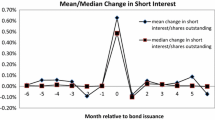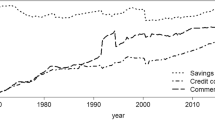Abstract
In this paper we offer direct evidence that financial intermediation does impact underlying asset markets. We develop a specific observable symptom of a banking system that underprices the put option imbedded in non-recourse asset-backed lending. Using a dataset for 19 countries and over 500 real estate investment trusts, we find that, following a negative demand shock, the “underpricing” economies experience far deeper asset market crashes than economies in which the put option is correctly priced.








Similar content being viewed by others
Notes
See “Interagency Guidance on Nontraditional Mortgage Product Risks” (http://www.federalreserve.gov/BoardDocs/SRLetters/2006/SR0615a2.pdf)
See for instance Smith et al. (2005) for a direct estimation of real estate values in Los Angeles. Other studies and popular articles on the fundamental real estate values include Case and Shiller (2003), Krainer and Wei (2004), Krugman (2005), Leamer (2002), McCarthy and Peach (2004), and Shiller (2005), Edelstein (2005) and Edelstein et al. (1999), among others.
The lending spread also covers the bank’s operating costs, but these are relatively small and constant throughout the market cycle.
If investors are diversified, only covariance with the overall economy affects the price of the asset. (see for instance Sharpe 1964). Even if the fortunes of real estate markets have an impact on the overall economy, changes in asset volatility will have a smaller, second-order effect on the asset price when compared to the effect on an underpriced option to default.
The price impact of real estate volatility changes through the covariance with the overall market are likely to be far smaller than the impact through changing the value of the option to default.
World Bank World Economic Indicators CD-ROM (2000).
In fact, virtually all commercial loans contain substantial prepayment penalties, so the option to prepay is not worth very much.
In addition to the deposit rate, one could use measures of the default spread based on the cost of capital for the lender or other risk-free securities, such as Treasuries. In this analysis we use deposit rates primarily because they are measured precisely and available for all countries in our sample.
References
Allen, F. (2001). Presidential address: Do financial institutions matter? Journal of Finance, 56, 1165–1176. doi:10.1111/0022-1082.00361.
Allen, F., & Gale, D. (1999). Innovations in financial services, relationships, and risk sharing. Management Science, 45, 1239–1253.
Allen, F., & Gale, D. (1998). Optimal financial crises. Journal of Finance, 53, 1245–1283. doi:10.1111/0022-1082.00052.
Case, K., & Shiller, R. (2003). Is there a bubble in the housing market? Brookings Papers on Economic Activity, 2, 299–342 Brookings Institution doi:10.1353/eca.2004.0004.
Clayton, J., Ling, D., & Naranjo, A. (2007). Investor sentiment and commercial real estate valuation. Working paper.
Edelstein, R. (2005). Explaining the boom cycle, speculation or fundamentals? The role of real estate in the Asian crisis. M.E. Sharpe.
Edelstein, R., Dokko, Y., Lacayo, A., & Lee, D. (1999). Real estate value cycles: A theory of market dynamics. Journal of Real Estate Research, 18(1), 69–95.
Eichholtz, P. (1996). Is international diversification more effective for real estate than it is for stocks and bonds? Financial Analysts Journal, 52, 56–62. doi:10.2469/faj.v52.n1.1967.
Herring, R., & Wachter, S. (1999). Real estate booms and banking busts—an international perspective. Washington: Group of Thirty.
Koh, W. T. H., et al. (2006). Underpriced default spread exacerbates market crashes. Univ. of Pennsylvania, Institute of Law & Econ Research Paper No. 06–13.
Krainer, J. & Wei, C. (2004). House prices and fundamental value. FRBSF Economic Letter. 2004–27.
Krugman, P. (2005). That hissing sound. The New York Times: August 8.
Leamer, E. (2002). Bubble trouble? Your home has a P/E ratio too. UCLA Anderson Forecast.
McCarthy, J., & Peach, R. (2004). Are home prices the next “Bubble”? FRBNY Econ Policy Rev, 10(3), 1–17.
Pavlov, A., & Wachter, S. (2004). Robbing the bank: Short-term players and asset prices. Journal of Real Estate Finance and Economics, 28(2/3), 147–160. doi:10.1023/B:REAL.0000011151.02848.1a.
Pavlov, A., & Wachter, S. (2006). The inevitability of market-wide underpricing of mortgage default risk. Real Estate Economics, 34(4), 479–496. doi:10.1111/j.1540-6229.2006.00175.x.
Sharpe, W. (1964). Capital asset prices: A theory of market equilibrium under conditions of risk. Journal of Finance, 19(3), 425–442. doi:10.2307/2977928.
Shiller, R. (2005). The bubble’s new home. Barrons (June):20.
Smith, M., Smith, G., & Thompson, C. (2005). When is a housing bubble not a housing bubble? Working paper.
World Bank World Economic Indicators, (2000). CD-ROM. Accessed 12 June 2008.
Acknowledgements
We thank John Clapp, Robert Edelstein, David Geltner, David Ling, the participants of the Cambridge-Maastricht-MIT real estate symposium and the Homer Hoyt Spring Meeting for valuable comments and suggestions. We thank Dr. Christopher Shun, CFP® of Menang Corporation, Malaysia, for insightful discussions related to this paper and the Global Property Research Indices used in this research. Andrey Pavlov gratefully acknowledges support from the Social Sciences and Humanities Research Council of Canada. All errors remain our own.
Author information
Authors and Affiliations
Corresponding author
Rights and permissions
About this article
Cite this article
Pavlov, A., Wachter, S. Mortgage Put Options and Real Estate Markets. J Real Estate Finance Econ 38, 89–103 (2009). https://doi.org/10.1007/s11146-008-9144-0
Published:
Issue Date:
DOI: https://doi.org/10.1007/s11146-008-9144-0




